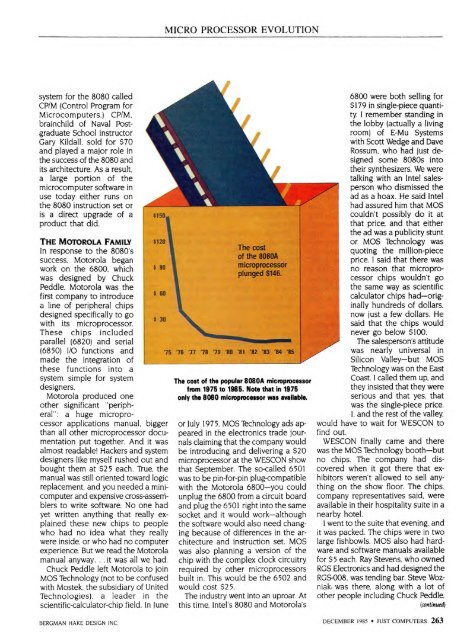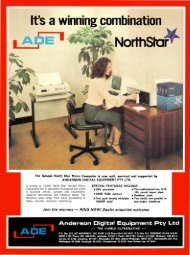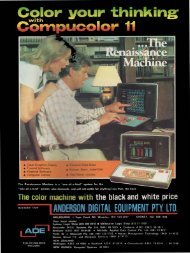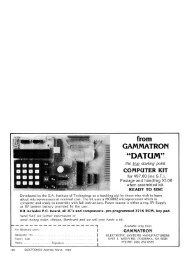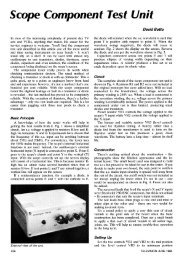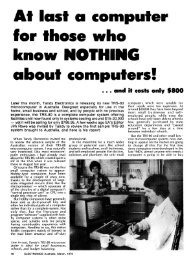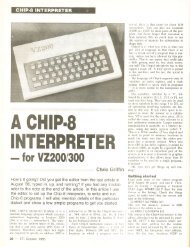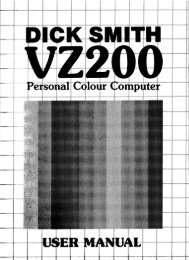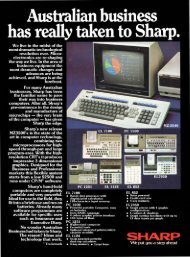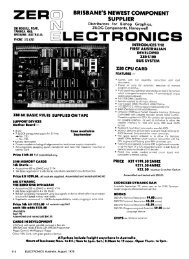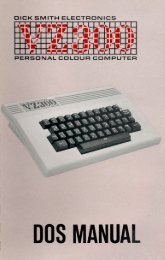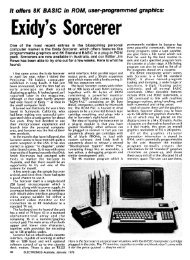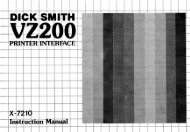MICRO PROCESSOR EVOLUTIONpurpose processor. Such a design,using s<strong>of</strong>tware rather than electronicsto do the calculating, would greatly increasethe memory requirements <strong>of</strong>the calculator—but then, Intel was inthe memory business. H<strong>of</strong>f also realizedthat this processor could be putto other applications and he sold theidea to Intel management.<strong>The</strong> Busicom engineers were stillpursuing their original design whenH<strong>of</strong>f and his group started work ontheir alternative design. And althoughthe Busicom engineers had simplifiedtheir design, each chip still had over2000 transistors, and it would take 12chips to make a working calculator.H<strong>of</strong>f's team figured it would take 1900transistors to build their processor.H<strong>of</strong>f's general-purpose processordesign was chosen over the Busicomdesign, and Intel got a contract fromBusicom to produce the chip thatlater became known as the 4004.Actually making the chip proved tobe difficult until Federico Faggin (wholater founded. Zilog) joined Intel inearly 1970. He took the chip fromconcept to silicon in just nine months.At first Intel sold the 4004 exclusivelyto BusicOrn, but in the summer <strong>of</strong>1971, it gained the right to sell thechip set to other manufacturers.In November 1971 Intel advertisedthe 4004 as a four-bit processor thatperformed 60,000 operations per second.By February 1972 Intel had sold$85,000 worth <strong>of</strong> chip sets.THE BIRTH OF 8-BITSAt the same time the 4004 was beingdeveloped, CTC (Computer TechnologyCorporation, now Datapoint)asked both Intel and Texas Instrumentsto design LSI chips for a newintelligent terminal. Both companiesproposed an 8-bit general-purposeprocessor. Note the pattern developing:4-bits for calculators because theywork in BCD (binary-coded decimal)and 8-bits for terminals because theydeal with ASCII characters.Interestingly. CTC chose neithersolution; it built its terminal with standardlogic ICs. But TI and Intel wentahead with their projects anyway. TIeventually got a patent on its chip262 JUST COMPUTERS • DECEMBER 1985design and the project at Intel gavebirth to the 8008.<strong>The</strong> 8008. introduced in April 1972,was the first 8-bit microprocessor onthe market. It required at least 20 supportchips, but it had 45 instructionsthat it executed at 300,000 instructionsper second, and it adddresseda whopping I 6K bytes <strong>of</strong> memory.That was a lot <strong>of</strong> memory then, andthe 8008 was a considerable upgrade<strong>of</strong> the 4004.<strong>The</strong> documentation for the 4004and 8008 was cryptic (at least itseemed so to me; I didn't have a computerbackground at the time). <strong>The</strong>documentation assumed that youknew what everything was before youstarted reading it (a still-common failing<strong>of</strong> technical literature).Intel's primary goal with the 4004and 8008 was to replace "randomlogic'=-another way <strong>of</strong> saying "lots <strong>of</strong>SSI and MSI wired together:' Few peoplethought that these chips weresuitable for general-purpose computing.But a few visionaries were intriguedby the possibility <strong>of</strong> owninga computer that could actually dosomething. Mlle, computer kits hadbeen <strong>of</strong>fered previously, but theywere more useful for demonstratingcomputer principles than for doingcomputing tasks. <strong>The</strong> availability <strong>of</strong>the 8008 changed all that.In 1973 Scelbi Computer ConsultingInc. announced the first generalpurposemicrocomputer based on the8008. This was followed by theRGS-008 from RGS Electronics. <strong>The</strong>n,in July 1974, Radio-Electronics magazineintroduced Jonathan Titus's Mark-8 ina series <strong>of</strong> construction articles.Until then, all computer articles andads had been confined to amateurradiopublications. <strong>The</strong> Mark-8 wasthe first computer to hit a generalinterestelectronics magazine. <strong>The</strong>seearly microcomputers were still moredemonstration tools than useful, butthe small-computer revolution hadbegun.THE MIGHTY 8080In April 1974 Intel changed the waywe think about computers forever.<strong>The</strong>y announced the 8080, a signif-icant upgrade to the 8008 that requiredonly six support chips, had 75instructions and a tenfold increase inthroughput over the 8008, and addressed64K bytes <strong>of</strong> memory. (Noprogram, most people thought, couldever be that large!)<strong>The</strong> 8080 design was proposed byFaggin, but the design team washeaded by Masatoshi Shima, a youngengineer Intel had wooed away fromBusicom. Having learned from thelimitations <strong>of</strong> the 4004 and 8008, thedesigners made improvements tomake their new chip a truly usefulcomputing engine. <strong>The</strong> 8080, the firstmicroprocessor not aimed at logic replacement,looked much more like acomputer than anything that hadcome before it, and it was much easierto use from a hardware standpoint.<strong>The</strong> January 1975 Popular Electronicsmagazine featured the first in a series<strong>of</strong> construction articles on the Altair8800, a so-called "minicomputer"based on the 8080. <strong>The</strong> Altair was designedby MITS (<strong>Micro</strong> Instrumentationand Telemetry Systems), whichwas founded by Ed Roberts as a vehiclefor supporting his experiments inelectronics. <strong>The</strong> whole Altair kit, includingthe 8080 processor, motherboard,power supply, front panel withlots <strong>of</strong> lights, and 256 bytes (not 256Kbytes) <strong>of</strong> memory sold for $395.People thought it was a misprint.<strong>The</strong> 8080 chip, introduced just ninemonths before, had been selling for$360 all by itself. But MITS had madea special deal with Intel, and the price<strong>of</strong> the Altair was real. MITS sold morecomputers in the first day than it hadhoped to sell during the whole life <strong>of</strong>the product.<strong>The</strong> Altair played a significant rolein the success <strong>of</strong> the 8080, largelybecause programmers now had areason (and a good excuse) to writes<strong>of</strong>tware for a microcomputer chip.Also, the Altair's open bus architecture(an improved version <strong>of</strong> whichlater became the S-100/IEEE 696 bus)allowed people to begin making peripheralsfor the computer.One such peripheral was a disk controllerfrom Digital <strong>Micro</strong>systems thatfeatured the use <strong>of</strong> a new operating
MICRO PROCESSOR EVOLUTIONsystem for the 8080 calledCP/M (Control Program for<strong>Micro</strong>computers.) CP/M,brainchild <strong>of</strong> Naval PostgraduateSchool instructorGary Kildall, sold for $70and played a major role inthe success <strong>of</strong> the 8080 andits architecture. As a result,a large portion <strong>of</strong> themicrocomputer s<strong>of</strong>tware inuse today either runs onthe 8080 instruction set oris a direct upgrade <strong>of</strong> aproduct that did.THE MOTOROLA FAMILYIn response to the 8080'ssuccess, Motorola beganwork on the 6800, whichwas designed by ChuckPeddle. Motorola was thefirst company to introducea line <strong>of</strong> peripheral chipsdesigned specifically to gowith its microprocessor.<strong>The</strong>se chips includedparallel (6820) and serial(6850) I/O functions andmade the integration <strong>of</strong>these functions into asystem simple for systemdesigners.Motorola produced oneother significant "peripheral":a huge microprocessorapplications manual, biggerthan all other microprocessor documentationput together. And it wasalmost readable! Hackers and systemdesigners like myself rushed out andbought them at $25 each. True, themanual was still oriented toward logicreplacement, and you needed a minicomputerand expensive cross-assenibiersto write s<strong>of</strong>tware. No one hadyet written anything that really explainedthese new chips to peoplewho had no idea what they reallywere inside, or who had no computerexperience. But we read the Motorolamanual anyway. . . it was all we had.Chuck Peddle left Motorola to joinMOS Technology (not to be confusedwith Mostek, the subsidiary <strong>of</strong> UnitedTechnologies), a leader in thescientific-calculator-chip field. In June<strong>The</strong> cost <strong>of</strong> the popular 8080A microprocessorfrom 1975 to 1985. Note that in 1975only the 8080 microprocessor was available.or July 1975, MOS lbchnology ads appearedin the electronics trade journalsclaiming that the company wouldbe introducing and delivering a $20microprocessor at the WESCON showthat September. <strong>The</strong> so-called 6501was to be pin-for-pin plug-compatiblewith the Motorola 6800—you couldunplug the 6800 from a circuit boardand plug the 6501 right into the samesocket and it would work—althoughthe s<strong>of</strong>tware would also need changingbecause <strong>of</strong> differences in the architectureand instruction set. MOSwas also planning a version <strong>of</strong> thechip with the complex clock circuitryrequired by other microprocessorsbuilt in. This would be the 6502 andwould cost $25.<strong>The</strong> industry went into an uproar. Atthis time, Intel's 8080 and Motorola's6800 were both selling for$179 in single-piece quantity.I remember standing inthe lobby (actually a livingroom) <strong>of</strong> E-Mu Systemswith Scott Wedge and DaveRossum, who had just designedsome 8080s intotheir synthesizers. We weretalking with an Intel salespersonwho dismissed thead as a hoax. He said Intelhad assured him that MOScouldn't possibly do it atthat price, and that eitherthe ad was a publicity stuntor MOS lbchnology wasquoting the million-pieceprice. I said that there wasno reason that microprocessorchips wouldn't gothe same way as scientificcalculator chips had—originallyhundreds <strong>of</strong> dollars,now just a few dollars. Hesaid that the chips wouldnever go below $100.<strong>The</strong> salesperson's attitudewas nearly universal inSilicon Valley—but MOSTechnology was on the EastCoast. I called them up, andthey insisted that they wereserious and that yes, thatwas the single-piece price.I, and the rest <strong>of</strong> the valley,would have to wait for WESCON t<strong>of</strong>ind out.WESCON finally came and therewas the MOS Technology booth—butno chips. <strong>The</strong> company had discoveredwhen it got there that exhibitorsweren't allowed to sell anythingon the show floor. <strong>The</strong> chips,company representatives said, wereavailable in their hospitality suite in anearby hotel.I went to the suite that evening, andit was packed. <strong>The</strong> chips were in twolarge fishbowls. MOS also had hardwareand s<strong>of</strong>tware manuals availablefor $5 each. Ray Stevens, who ownedRGS Electronics and had designed theRGS-008, was tending bar. Steve Wozniak,was there, along with a lot <strong>of</strong>other people including Chuck Peddle,(continued)BERGMAN HAKE DESIGN INC DECEMBER 1985 • JUST COMPUTERS 263


